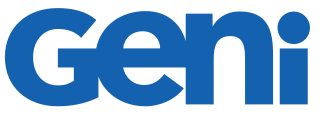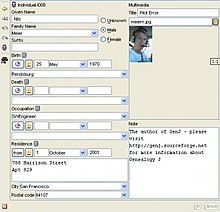
Genealogy is the study of families, family history, and the tracing of their lineages. Genealogists use oral interviews, historical records, genetic analysis, and other records to obtain information about a family and to demonstrate kinship and pedigrees of its members. The results are often displayed in charts or written as narratives. The field of family history is broader than genealogy, and covers not just lineage but also family and community history and biography.
The Book of Genesis is the first book of the Hebrew Bible and the Christian Old Testament. Its Hebrew name is the same as its first word, Bereshit. Genesis purports to be an account of the creation of the world, the early history of humanity, and the origins of the Jewish people.
Fergus Mór mac Eirc was a possible king of Dál Riata. He was the son of Erc of Dalriada.
FamilySearch GEDCOM, or simply GEDCOM, is an open file format and the de facto standard specification for storing genealogical data. It was developed by The Church of Jesus Christ of Latter-day Saints, the operators of FamilySearch, to aid in the research and sharing of genealogical information. A common usage is as a standard format for the backup and transfer of family tree data between different genealogy software and Web sites, most of which support importing from and exporting to GEDCOM format.
Genetic genealogy is the use of genealogical DNA tests, i.e., DNA profiling and DNA testing, in combination with traditional genealogical methods, to infer genetic relationships between individuals. This application of genetics came to be used by family historians in the 21st century, as DNA tests became affordable. The tests have been promoted by amateur groups, such as surname study groups or regional genealogical groups, as well as research projects such as the Genographic Project.

The Society of Genealogists (SoG) is a UK-based educational charity, founded in 1911 to "promote, encourage and foster the study, science and knowledge of genealogy". The Society's Library is the largest specialist genealogical library outside North America. Membership is open to any adult who agrees to abide by the Society's rules and who pays the annual subscription. At the end of 2010, it had 11,014 members.
FamilySearch is a nonprofit organization and website offering genealogical records, education, and software. It is operated by the Church of Jesus Christ of Latter-day Saints and is part of the church's Family History Department (FHD). The Family History Department was originally established in 1894, as the Genealogical Society of Utah (GSU); it is the largest genealogy organization in the world.
A genealogical DNA test is a DNA-based genetic test used in genetic genealogy that looks at specific locations of a person's genome in order to find or verify ancestral genealogical relationships, or to estimate the ethnic mixture of an individual. Since different testing companies use different ethnic reference groups and different matching algorithms, ethnicity estimates for an individual vary between tests, sometimes dramatically.
The Social Security Death Index (SSDI) was a database of death records created from the United States Social Security Administration's Death Master File until 2014. Since 2014, public access to the updated Death Master File has been via the Limited Access Death Master File certification program instituted under Title 15 Part 1110. Most persons who have died since 1936 who had a Social Security Number (SSN) and whose death has been reported to the Social Security Administration are listed in the SSDI. For most years since 1973, the SSDI includes 93 percent to 96 percent of deaths of individuals aged 65 or older. It was frequently updated; the version of June 22, 2011 contained 89,835,920 records.
Ancestry.com LLC is an American genealogy company based in Lehi, Utah. The largest for-profit genealogy company in the world, it operates a network of genealogical, historical records, and related genetic genealogy websites. It is owned by The Blackstone Group, which acquired the company on December 4, 2020, in a deal valued at $4.7 billion.

Gramps, formerly GRAMPS, is a free and open-source genealogy software. It is developed in Python using PyGObject and utilizes Graphviz to create relationship graphs.
Personal Ancestral File (PAF) was a free genealogy software program provided by FamilySearch, a website operated by the Church of Jesus Christ of Latter-day Saints. It was first released in 1983, last updated in 2002, and formally discontinued in 2013. It allowed users to enter names, dates, citations and source information into a database, and sort and search the genealogical data, print forms and charts, and share files with others in GEDCOM format. PAF also linked images and other media files to individual records.
This article compares several selected client-based genealogy programs. Web-based genealogy software is not included.

Geni is an American commercial genealogy and social networking website, founded in 2006, and owned by MyHeritage, an Israeli private company, since November 2012. As of 2024, MyHeritage has kept its genealogical website separate from Geni's website, though you can still match Geni profiles to trees on MyHeritage and to other family tree sites and digitized records.

LifeLines is a free open-source genealogy software tool to assist family history research. LifeLines primary strengths are its powerful scripting language and the ability to easily import and export information in the GEDCOM format. It was the first open-source genealogy program for Unix. The Lifelines scripting language is now supported by several other open-source programs.
Peter Clement Bartrum was a researcher and genealogist who, from the 1930s onwards, specialised in the genealogy of the Welsh nobility of the Middle Ages.
Family.Show is a free and open-source genealogy program written in C# and running on the .NET Framework. Microsoft partnered with and commissioned Vertigo Software in 2006 to create it as a reference application for Microsoft's latest UI technology and software deployment mechanism at the time, Windows Presentation Foundation and ClickOnce. The source code has originally been published on Microsoft's CodePlex website. It has since been forked and development continues independent of Microsoft on GitHub.

Bacheldre is a small settlement in Powys, Wales. It is near the A489 road and is 5 kilometres (3 mi) southeast of the town of Montgomery.

WeRelate.org is an American wiki genealogy Web site that provides genealogy tools and data. WeRelate is a nonprofit organization, funded by tax-deductible donations, and is managed by unpaid volunteers. WeRelate had over 2 million person pages by March 2011 and claimed to be the "world's largest genealogy wiki".

WikiTree is a genealogy website that allows users to research and to contribute to their own family trees while building and collaborating on a singular worldwide family tree within the same system. WikiTree is free for the user and financed via advertisements displayed to unregistered users. WikiTree is owned and hosted by founder's company Interesting.com, Inc.









